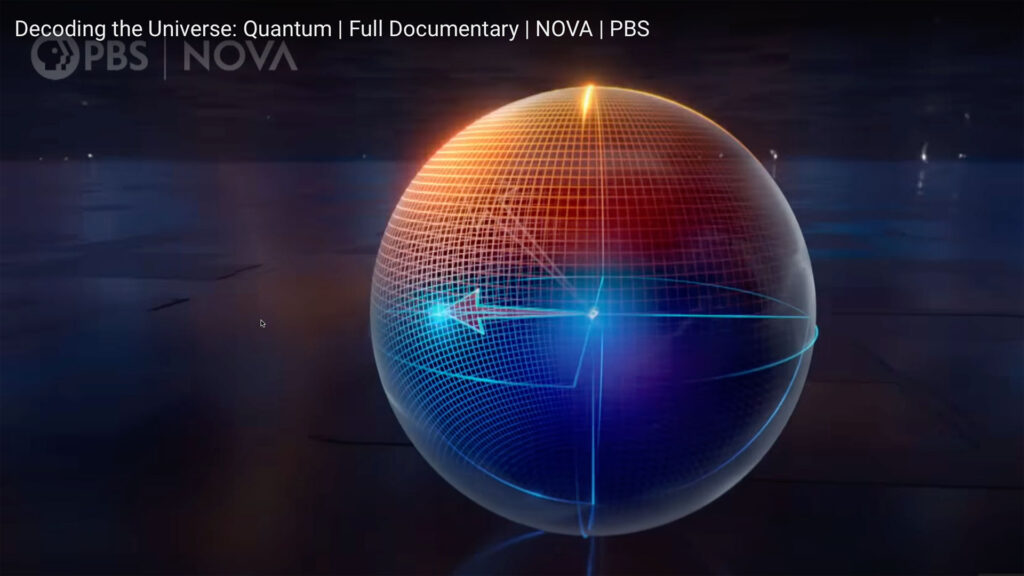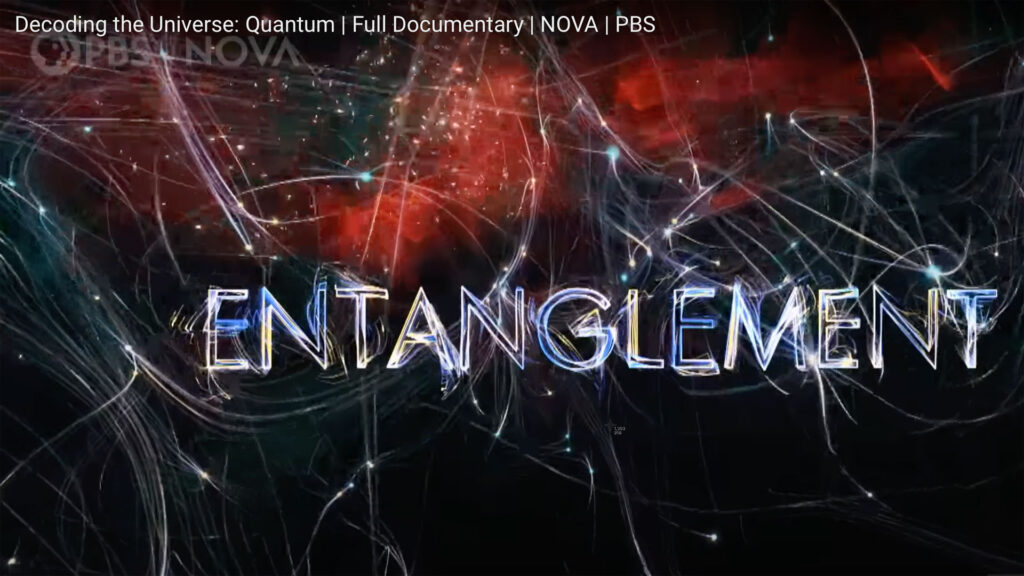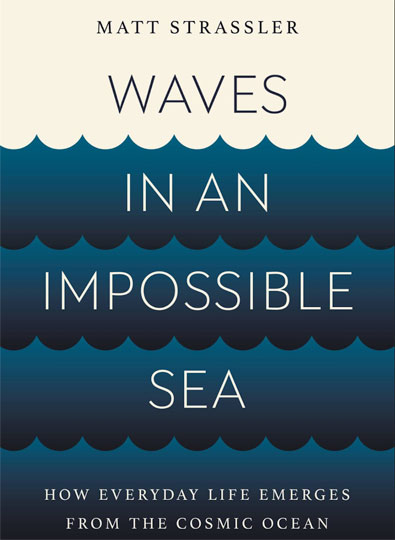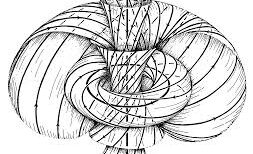[Draft 1-6-2025 see comments for updates]

Yeah, quantum physics is weird. What might be called Weirdness 1.0 (QM), 1.1 (QED), 1.2 (QCD), etc., as I’ve written about, have embedded frozen tropes in the popular psyche. But can’t we do better?
When physicists talk about analogies – use everyday language (terms) to talk about the quantum realm – and connections with our everyday world, yes, they know what they mean. Namely, the mathematical framework and practical use (as in grand particle accelerators, GPS, quantum computers, photonics, cool stuff in our smartphones, etc.). Typically nary an equation or mention of the word field, as an example.
But that physicist-to-physicist rapport is not the takeaway for mere mortals, and not what’s in the many recaps by science communicators.
So, is there any progress in visualization, in demystifying quantum field theory (QFT), getting to what is actually an even more profound weirdness. Like Weirdness 2.0?
Well, to illustrate the current landscape of language, here’re three examples which grabbed my attention recently:
- a PBS video episode
- a new book by a physicist
- a video interview with a veteran, award winning physicist

.1. PBS NOVA’s episode “Decoding the Universe: Quantum” (Nov 6, 2024)
My general reaction is: a hackneyed recap, not moving the dial beyond Quantum Weirdness 1.0.
Here’s a summary from my annotated transcript of the show.
Good production values. For concepts, the usual suspects (not really new voices or new insights from old voices), Typical touting of how QM is historically revolutionary and important and practical.
There’s the black hole mantra, and usual tropes, … yet an uneven vocabulary level, sometimes advanced word bombs.
The physics callouts are a mix of ‘quantum mechanics’ [used 16 times] … and ‘quantum physics’ [used 15 times] … but the episode closes with ‘quantum mechanics’ … mechanics is like working on a car? – machinery … There’s no mention of fields or ‘quantum field theory’ … I felt stuck in quantum physics 1.0.

And, naturally, there’s nothing like ending (after mostly a classical detour) with spookiness – ‘quantum entanglement.’ But this exposition has been done many times, often better (and on smaller budgets). I’m looking for a better metaphor than the term ‘connected’ for entangled quanta – to avoid any notion of springs between balls, for example. But this chapter offers a path to Weirdness 2.0, especially via quantum computing. But there’s that term ‘superposition’ in the way for most people (and an allusion to Bloch sphere).
The chapter on atomic clocks is good (almost as sacred artifacts), a promo for introducing the NIST, GPS. As well as a ramble into more detail about an atomic model, a term drop for ‘resonant frequency’.
Lasers, of course – practically everyone’s familiar with laser pointers. But the discussion misses an opportunity to clarify laser purity (how near to true monochromatic light). Good promo for LIGO.
The best chapters, in fact, mainly deal with the classical physics of Relativity theory (special, general).
Basically, this episode is like a highlight reel, perhaps to inspire some to explore more & deeper, but it doesn’t really build from everyday curiosity or connections like other more engaged science communicators (like Wired’s series on “5 levels” of understanding). Probably a generative AI might do as well, scraping from textbooks.
The biggest missed opportunity is that the popular wave-particle analogy (the particle analogy itself) conflates the point of the historical observations with billiard balls rather than the notion of ‘discrete’ and ‘indivisible’ and ‘localized’ – in the context of measurements. Down the rabbit hole again, eh. Strassler’s book (referenced below) addresses this conflation.
• YouTube > NOVA PBS Official > “Decoding the Universe: Quantum” (Nov 6, 2024)
(Description)
When we look at the world at the tiniest scales in the subatomic realm, things get weird – very weird. Welcome to the quantum universe, where particles can spin in two directions at once [hmm], observing something changes it [hmm], and something on one side of the galaxy can instantly affect something on the other, as if the space between them didn’t exist [hmm]. Buckle up for a wild ride through the discoveries that proved all of this to be true …
Chapters
00:00 Introduction
08:07 What is Quantum Mechanics?
15:55 Atomic Clocks: The Science of Time
26:41 Detecting Ripples in Space-Time
37:37 What is Quantum Entanglement?
50:34 Conclusion

.2. New book
Wow … finally … a popular science book which “gives even the lay reader a comprehensive but accessible perspective on physics” … maybe moves the dial toward Weirdness 2.0?
Here’s the Big Think’s book review / promo.
(quote)
It’s rare that a book comes along that changes the way experts in their field think about the fundamentals, while simultaneously being accessible and informative to those without expert knowledge themselves.Strassler, a world-renowned expert in particle physics in his own right (and longtime science blogger), takes the reader on a whirlwind tour of physics from a conceptual point of view.
(end quote)
Topics include: motion-energy, the “coasting law” (aka Newton’s first law), mass, waves (medium, field, wave), fields … the quantum … “the Cheshire Cat’s grin — a grin without the cat.”
Can there be a field or wave without a medium?

• Big Think > “‘Waves in an Impossible Sea’: The 2024 science book of the year” by Ethan Siegel (December 17, 2024) – An exclusive interview with Matt Strassler on his journey into fundamental physics, an explanation of the Higgs field.
(excerpts)
Matt Strassler (MS): It always bothers me when we physicists water down our science too far, so that the result is misleading or even false [physics phib]. I feel that doing so underestimates the intelligence of our readers and listeners. To make matters worse, our bad explanations often contradict our good ones, creating logical inconsistencies that make it impossible for a non-expert to make sense of what we’re saying. There has to be a more intelligent and more honest way to convey the lessons of science.I took it as a personal challenge to write a book with a correct yet non-technical explanation of the Higgs field and how it works.
In the end, though, the Higgs field was really a subplot. The heart of the book is its story of fields and of how elementary particles arise from them, and why an elementary particle like an electron is more a rapidly vibrating wave than a tiny dot. Once this is clear, understanding what the Higgs field does and why it’s so important, and what the discovery of the Higgs boson really means, becomes much easier.
MS: I like your phib better than most, because it avoids misrepresenting what mass is. The ones that compare the Higgs field to a space-filling soup or molasses, and say that the Higgs field gives mass to things by slowing them down, are literally medieval! They violate two of Isaac Newton’s three laws of motion, encouraging us to imagine, falsely, that having mass makes it difficult for an object to move. [Spot on!]
… elementary particles are vibrating entities [Yeah!]
A third and very important choice was to replace the word “particle”, in the last third of the book, with the word “wavicle”, a term from the 1920s, which is also used these days by some other scientists, including Neil deGrasse Tyson and Frank Wilczek. The problem with calling an electron a “particle” is that it immediately makes you imagine an object in the shape of a tiny dot. But in fact, in quantum field theory (the modern language of particle physics), an electron is never a dot. It is always spread out to a greater or lesser degree, and it is wavelike in various ways, including the crucial fact that it is always vibrating. What makes it “particle-like” is not its shape but its indivisibility — the fact that it travels as an indivisible unit.
Joining the suffix “-icle” to the word “wave” captures both the shape of electrons and the fact that they come in individual units — that you can’t divide an electron into pieces. In this sense, “particle” creates misconceptions about what electrons and their cousins are, whereas “wavicle” opens our minds to the unfamiliar ideas that are needed to understand electrons better.
And so the mass of an elementary “wavicle”, a vibrating entity, is proportional to the energy that it carries inside it, which in turn is proportional to the frequency of its vibration. [Quantum topology is another matter.]
[Yes, constraints are important!] A top quark is short-lived [unlike electrons] because its vibration is damped by the weak nuclear force and the Higgs force, which, together with quantum physics, cause it to decay away, transforming it into a W boson and a bottom quark. The damping also causes the top quark to have an imprecisely defined frequency, and thus a precise measurement of its mass won’t give exactly the same answer every time.
MS: The idea that both may have a medium — more precisely, that gravity and electromagnetism are properties of a single medium — is an old idea from the 1920s, due to Kaluza and Klein, who were thinking about extra dimensions of space.
Book reference (currently reading)
• Strassler, Matt (2024). Waves in an Impossible Sea: How Everyday Life Emerges from the Cosmic Ocean. Basic Books. Kindle Edition.
.3. Institute of Art and Ideas video interview with Roger Penrose
Watch “We need to ‘gravitise’ quantum mechanics, not quantise gravity | Roger Penrose | Full interview” on YouTube
Roger Penrose is a world-renowned mathematician, mathematical physicist, philosopher of science and Nobel Laureate in Physics. He is best known for his work on general relativity and sharing the Wolf Prize for Physics with Stephen Hawking for his work on black holes.
CONTEXT


• Isaac Newton Institute for Mathematical Sciences > Programs & Workshops > Twistor Theory (2 September 2024 to 27 September 2024)

Well, the context is Twistor theory, which sort of addresses my general question as to whether visualization of QFT requires additional (so-called higher) dimensions (as in complex number space).
• Wiki > Twistor theory
Projective twistor space PT is projective 3-space CP^3, the simplest 3-dimensional compact algebraic variety. It has a physical interpretation as the space of massless particles with spin. … the space of chiral (Weyl) spinors … of Minkowski space …
In its original form, twistor theory encodes physical fields on Minkowski space in terms of complex analytic objects on twistor space via the Penrose transform.
GENERAL REACTION
An interesting ramble – talking head – on relativity theory and QM. Historical anecdotes. Not for a general audience. Some key terms but no visualization of what ‘gravitise’ quantum mechanics might mean (need to look elsewhere, eh).
Basically a perspective on Weirdness 1.0, with some notes on mathematical discontinuities and dimensions. Split a quantum field into positive and negative frequencies … complex numbers (sphere) … geometry … photon paths … congruence … twist around … how many dimensions to describe a light ray (photon path) vs. point … [cf. quantum topology?] … frequency and helicity, separate concepts … “QM is not quite right when it comes to gravity” …
There are YouTube videos on twistor theory. Here’s an example:
• YouTube > Know Time > “Twistor Theory Explained: A New Approach to Physics” (Jan 12, 2024) – Peter Woit, theoretical physicist, author and professor of mathematics at Columbia University, talks about Sir Roger Penrose and Twistor Theory. Talking head.
ADDTIONAL NOTES (from transcript)
1963 Twistor theory – an area of math in order to treat quantum theory in relation to relativity theory … collapse of the wave function to try make sense of QM.
gravitise QM … flaw is the collapse of wave function – the (continuous) Schrödinger equation … view of reality (whether the collapse of the wave function is real) … glitch of logic … “the collapse of the wave function (a real physical process) does not harm the Schrödinger equation.” … the collapse (at a certain level) when the system gets too big in the sense of gravitation, the stage when … Planck mass … tension between Einstein’s theory of gravity and QM. … principle of equivalence …
(quotes from transcript)
I think my best argument was where you look at a tension between these two principles, the principle of equivalence (free fall gets rid of gravity) and the principle of superposition in quantum mechanics. That is, that if you can have one kind of state and another kind of state then they can both happen together, so you can have a particle here the same particle could be there. It can, there are many states where it’s here and there at the same time.And quantum mechanics depends on this being possible. It’s what’s called linearity – you can add that state to that state, and it’s a per good state.
• YouTube > The Institute of Art and Ideas > “We need to ‘gravitise’ quantum mechanics, not quantise gravity | Roger Penrose | Full interview” (Dec 26, 2024) – Sir Roger Penrose speaks about key turning points in his life’s work, and the ‘blatant contradiction’ in quantum mechanics that is yet to be solved.
00:00 Introduction
00:29 What are you most proud of in your career?
01:58 The collapse of the wave function
07:50 The Diósi–Penrose model
11:01 Were you ever led to discover a breakthrough by flawed reasoning?
12:02 What has been your equivalent of Einstein’s ‘happiest thought’?
12:52 The Kennedy assassination
14:32 Working out Twistor theory in a car ride back from southern Texas
23:35 Two-component vs four-component spinors
24:42 Meeting Paul Dirac
27:48 Was Einstein wrong?
28:50 The wrong wrongness
(excerpts from transcript)
I think my best argument was where you look at a tension between these two principles, the principle of equivalence (free fall gets rid of gravity) and the principle of superposition in quantum mechanics. That is, that if you can have one kind of state and another kind of state then they can both happen together, so you can have a particle here the same particle could be there. It can, there are many states where it’s here and there at the same time.
And quantum mechanics depends on this being possible. It’s what’s called linearity – you can add that state to that state, and it’s a per good state.
The other thing he told me was that in Quantum field Theory the most important thing is the splitting of field amplitudes into positive and negative frequencies. Now don’t, I can’t really, going about, being a little more technical, what that means, but what it usually means to people is you take what’s called the Fourier decomposition and then you take the positive part each time, so got different, the different frequencies, if you like, and you take each frequency and you split it into to the positive negative frequencies, and you do that all the way along. I didn’t like that much because that splitting is not formally invariant, and if you want to do it from Maxwell Theory would be much nicer to have a way of saying it which didn’t devolve all this Fourier decomposition
So I thought, well, there is a way of doing that, you just think, I should explain this all involves complex numbers. Quantum mechanics is absolutely bound up with complex numbers, which I, is one of the things which attracted me to the subject. I was both attracted and repelled by the subject, of like, because [if] you like complex analysis absolutely, it’s an extremely beautiful theory in mathematics.
It’s like a circle. you see 0 1 2 3 4 , it gets closer and closer Infinity then minus infinity is the same point 2 one zero, a beautiful Circle. You see think of that as the equator of a sphere. You have a function on that equator that’s the real numbers, and you look at the part of that function which extends into the positive Hemisphere and the part which extends into the negative hemisphere. One is the positive frequency and the other is the negative frequency and I thought that’s much more beautiful the idea. You could talk about this fundamental feature of quantum field theory in terms of this geometry of the sphere.
When I say light ray, I’m thinking the the of the trajectory of a photon, if you like, so it moves along, but in the history of the space time it’s a line, so it’s a space-time line, so when I say light ray that’s what I mean. gray [?] sometimes people, now the well I call the Robinson congruence, it was ior’s [Diósi?] idea, you take the light red that all the other light RS [?] meet see there all the other ones meet is, and you construct your solution of Max’s equation on, on the basis of those lines, that’s a very beautiful solution, but what you can also do is displace this light ray into the complex, and there are the ones who still there, they’re still the ones that meet it, they sort of meet it in in the imaginary way, but they do still, and you get the same congruence as it’s called, but it twists around, and it doesn’t have any singularities, it doesn’t meet the line you see where all the lines meet it’s a sort of singular place.
Why is that exciting to me, because I’m looking for a space where the real things that you talk about – that’s the light rays, I should be thinking not points but light rays, that was the key, think of light rays, don’t think of points. The points of SpaceTime are four dimensional, and if you complexive it’s eight dial [?] it’s no use to me, but I think of the light rays, and then I comple complexify them in the subtle Robinson way, then I only get six dimensions, so my space is split into two halves the ones which twist right-handed, the one twist left-handed, and the ones which don’t twist which are the light rays and that was my key thought.
Additional references
- More on Penrose – a biography
- Physics World > Book review > “So you think you know Roger Penrose? Be prepared to be shocked” by Chanda Prescod-Weinstein (02 Apr 2025 ) – A book review of The Impossible Man: Roger Penrose and the Cost of Genius by Patchen Barss
Related posts

- Proton soup – a turbulent, dynamically complicated structure
- Demystifying QFT – A quantum’s tail – no halfsies
- Demystifying QFT – Grid as superconductor
- Wavepackets and uncertainty principle
- QFT – fields and wave packets
- Reality is fields
- Reality of fields, language of particles – the Standard Model

Well, here we go again … yet another recap … although it’s really about fields (QFT) … but here there be ‘particle’ words … quantum particles, photons – real & virtual … here there be Feynman diagrams … (virtual) mediation of the EM force (somehow in the math). I felt stuck in Quantum Weirdness 1.0.
Well, at least Siegel put “exchanged photons” in quotes. And he does mention quantum field theory. And he does use Matt Strassler’s term ‘wavicle’ (for which Siegel wrote a book review, eh).
He starts by clarifying what real photons are … well, sort of, since there’s no mention of wavepackets, just a standard EM wave graphic. Another diagram uses standard plane wave squiggles [1].
And a “visualization of a quantum field theory” is a standard quantum vacuum fluctuation animation (from Wiki).
So, no advance in visualization: no mention that Feynman really was a ‘particle’ guy; no mention that the sum-over-all-paths thing really might be about the need to accomodate photons as extended wavepackets; no mention of variations in energy density & interactions of quanta in a fluid-like Grid (Wilczek) and resulting topology of field gradients, … Just more again about doing the math.
• Big Think > “Ask Ethan: How do photons mediate both attraction and repulsion?” by Ethan Siegel (January 10, 2025) – The electromagnetic force can be attractive, repulsive, or “bendy,” but is always mediated by the photon. How does one particle do it all?
(excerpts)
Notes
[1] As a wavepacket, the photon emitted (or “absorbed”) in an electron’s state transition is NOT monochromatic (a plane wave).
Related posts
• Virtual attraction
Well, on my to-do list for commentary, there’re a few more articles by well-known physicists. Here’s a recent one by Brian Cox (below).
PROLOGUE
Before my take on Cox’s presentation (below), here’s my take on quantum physics.
Here’s a quick sketch of my visualization for Quantum Weirdness 2.0. The landscape at the “tiniest scales in the subatomic realm.” Something beyond our ability to conjure up other than with mathematical models.
Nevertheless, imagine energy packets (bundles) which are complex superpositions of numerous (perhaps unlimited) wave forms in a foundational fluid-like medium (field). Wavepackets extended in spacetime.
These packets are “particles” only in the sense that they are ‘discrete’ and ‘indivisible’ and ‘localized.’
These energy packets are defined relationally. In a sense that complex superpositions are tangled components with a dynamic topology (with an uncertainty relationship for position & momentum, eh).
Relational also in the sense that their states depend on interference / interaction with other packets (even those in measurement devices). Identical “things” do not have identical, intrinsic properties when measured anywhere – independent of context [1] [2].
As such, any so-called properties which we might measure are indeterminate (identical conditions do not lead to identical results). While unified, there’s no simple (non-complex) entity to measure. One can expect probabilistic values for any such property. For example, spin.
Our everyday world emerges from the interplay of superposition and entanglement within a multilayered superconducting Grid (Wilczek).
MY TAKE ON COX’S PRESENTATION
Well, the good news is a reconsideration of the way to teach Quantum Physics 101, an introductory course to the topic. The bad news is that Cox still uses the phrase “quantum mechanics” (although the article’s title uses “quantum physics“) and a particle framework, when his point really is to skip over all that historical “mechanical” confusion (baggage).
I like the way he starts with the notion of “spin.” The tired analogy of a heads-or-tails coin is problematical, but that introduces the notion of superposition, with “any mixture of heads and tails.” (Many eyes glazed over at this point?)
That “perfectly legitimate description [superposition] of the state of the configuration,” however, is just left dangling for mere mortals, with just a note that electrons (still called particles) have a property called spin which is a mixture of ‘up’ and ‘down’ (yet only measured as up or down, eh).
He clarifies that this “mixture” is not a probability theory thing (like weather forecasting, due to our incomplete knowlege or understanding), but “fundamental” – intrinsic (yeah, okay).
Then he gets to the “double-slit experiment” (which Art Hobson also focuses on in his book Tales of the Quantum). And Feynman’s lectures from the 1960’s.
So, a reasonable place to start the discussion; but, basically, still a recap. Stuck in Quantum Weirdness 1.0. He excludes any middle perspective on so-called particles. Just the typical “bullet” and water wave tropes. Although he does introduce the phrase “a big extended wavy thing” (à la Hobson).
At least Cox avoids the term wavicle. But there’s no notion of photons or electrons et al. as (quantized) bundles of energy – wavepackets. Quanta as topological superpositions of many wave forms. Energy packets with an inherent uncertainty for their measured properties. Which indeed interfere with other packets (and related fields) in devices (or even with themselves).
In the end, however, while there’s weirdness, “well, it doesn’t really matter so much practically, right?”
Then Cox discusses quantum computers, that practical landscape: “You can also then ask the question, well, what happens if I get another one [qubit], two electrons together? These can be in what’s called an “entangled state.” And the haze of references – the standard liturgy – to the “Bell state,” etc. (and the ususal handwaving over the 2^n supremacy of qubits over bits in characterizing the state of a system).
• Big Think > “Physicist Brian Cox explains quantum physics in 22 minutes” (April 2025) [talking head video] – “Quantum mechanics and quantum entanglement are becoming very real. We’re beginning to be able to access this tremendously complicated configuration space to do useful things.”
(quotes from transcript)
Notes
[1] Re the point that “Identical ‘things’ do not have identical, intrinsic properties when measured anywhere – independent of context,” I found this article interesting. It’s, as yet, about a theoretical (mathematical) construct, but explores the question as to the strict definition of indistinguishability in the context of superpositions.
Terms: Anyons (Wilczek), Rydberg atoms
• Quanta Magazine > “‘Paraparticles’ Would Be a Third Kingdom of Quantum Particle” by Shalma Wegsman (April 11, 2025) – Rather than all (boson) or none (fermion) packing, is there another class of quanta “able to pack just a few particles into the same state, before getting crowded and forcing others into new states?”
[2] Re relational quantum physics
• Wiki > Carlo Rovelli
• AI Overview [carlo rovelli on reality of the wave function]
Carlo Rovelli, in his relational interpretation of quantum mechanics, does not view the wave function as a direct representation of reality, but rather as a tool for calculating the probabilities of interactions between systems. He argues that the wave function is a “calculation device” that keeps track of past quantum events, rather than a reflection of a fundamental, underlying reality. This perspective shifts the focus from the wave function itself to the relationships and interactions between systems, where reality is constituted by these interactions.
Elaboration:
Rovelli’s relational quantum mechanics proposes that the quantum state of a system is only meaningful relative to another system. This means that the wave function, which describes the quantum state, does not represent an objective, pre-existing property of a system, but rather a description of the system’s relationship to another system.
Key points of Rovelli’s view:
Quantum mechanics is a theory of interactions:
Reality is not composed of standalone objects with pre-defined properties, but rather emerges from the interactions between systems.
Wave function as a calculation tool:
The wave function is not a representation of reality, but a mathematical tool used to predict the outcomes of interactions between systems.
Relative nature of reality:
The properties of a system are only real in relation to other systems, and different observers can have different, equally valid, descriptions of the same system.
Challenge to realistic interpretations:
Rovelli’s interpretation challenges the idea that the wave function represents a fundamental, underlying reality, such as in interpretations like many-worlds interpretation.
In essence, Rovelli’s relational quantum mechanics provides a different perspective on the wave function, emphasizing its role in describing interactions rather than directly representing a fundamental reality. This interpretation offers a way to address some of the puzzles of quantum mechanics, such as the measurement problem and the nature of quantum entanglement, by focusing on the relational nature of reality.
Generative AI is experimental
Also, Rovelli argues in this article that Max Born and his collaborators may help clear “confusion about what quantum phenomena tell us about reality.”
• New Scientist > “Carlo Rovelli on what we get wrong about the origins of quantum theory” by Carlo Rovelli (15 April 2025) – “Introductory quantum physics classes … I think the emphasis on Schrödinger’s waves is responsible for today’s confusion about what quantum phenomena tell us about reality.” [Paywall]
• “Matrix mechanics mis-prized: Max Born’s belated nobelization” by John L. Heilbron and Carlo Rovelli (18 October 2023)
• AI Overview
Carlo Rovelli, in his work, emphasizes that Max Born’s contribution was not solely about the probabilistic interpretation of the wave function, but also about recognizing the fundamental role of matrices in quantum mechanics. Rovelli highlights that Born’s work, alongside Werner Heisenberg and Pascual Jordan, established the foundations of matrix mechanics, a formulation of quantum theory that was later overshadowed by Erwin Schrödinger’s wave mechanics. Rovelli suggests that Born’s Nobel Prize, awarded in 1954, was a belated recognition of his earlier, more fundamental contributions, which included understanding the statistical interpretation of the wave function before Schrödinger’s wave mechanics.
Here’s a more detailed breakdown:
Rovelli’s Perspective:
Rovelli argues that Born’s work, particularly his collaboration with Heisenberg and Jordan, was crucial in developing the mathematical framework of quantum mechanics, specifically matrix mechanics. This framework, which predates Schrödinger’s wave mechanics, provided a solid foundation for understanding quantum phenomena.
The Wave Function:
While Born’s interpretation of the wave function as describing probabilities is important, Rovelli emphasizes that Born’s contributions extended beyond that, including his work on matrix mechanics.
The Nobel Prize:
Rovelli notes that Born’s Nobel Prize was awarded for the probabilistic interpretation of the wave function, but suggests that this was a delayed recognition of his earlier and more fundamental contributions to quantum mechanics.
The History of Quantum Theory:
Rovelli and historian of science John Heilbron analyze the historical development of quantum theory, highlighting that the evaluation of scientific contributions evolves as new ideas emerge. In this context, Rovelli suggests that Born’s work on matrix mechanics deserves more recognition for its foundational role in quantum mechanics.
Generative AI is experimental
References
• Phys.org > “Proving quantum computers have the edge” by Whitney Clavin, California Institute of Technology (4-10-2025)
Also from my to-do list for commentary … an interview.
Here’s an article (below) about Gerard ‘t Hooft‘s dissatisfaction with quantum mechanics. (Is this the same as quantum physics?) Not a hint of visualization.
‘t Hooft seeks to explain quantum (particle) trajectories in an exact, deterministic way. Without any mysticism – because “the world is very simple and straightforward.”
(quotes from transcript)
(end)
And I’m with him as far as quanta not being pure points. That there’s some topology. More degrees of freedom.
And I agree that quanta require no “strange sort of supernatural [unknowable] feature” (or extra dimensionality?). He feels that “quantum mechanics is already too far away from reason.” But I wonder about his desire for some type of clock-like deterministic mechanism
(quote)
(end)
And indeed quantum physics is predicated on superposition. And that such framing is a mathematical model, an approximation of reality (nature). I like his question: “Can you formulate quantum mechanics without a superposition principle?”
(quote)
(end)
• Scientific American > “Quantum Physics Is on the Wrong Track, Says Breakthrough Prize Winner Gerard ‘t Hooft” by Lee Billings (April 8, 2025) – Dutch theoretical physicist (professor emeritus at Utrecht University in the Netherlands) reflects on a theory which “can only make statistical predictions.” [A quest for quantum determinism?]
(quotes from transcript)
References
• Phys.org > “Researchers discover a new type of quantum entanglement” by Technion – Israel Institute of Technology (4-11-2025) – A study [published in the journal Nature] unveils a newly discovered form of quantum entanglement in the total angular momentum of photons confined in nanoscale structures [a thousandth the size of a hair], the first discovery of a new quantum entanglement in more than 20 years.
• Tech Gig > “Quantum Physics Needs a Reset, Says Nobel Prize Winner Physicist” by Abhijeet V Singh (10 Apr 2025) – Hooft [Gerard ‘t Hooft] believes that the core idea behind the concept of quantum mechanics does not match reality.
• MIT Tech Review > “Inside the hunt for new physics at the world’s largest particle collider” by Dan Garisto (February 20, 2024) – LHC hasn’t seen any new particles since the discovery of the Higgs boson in 2012.